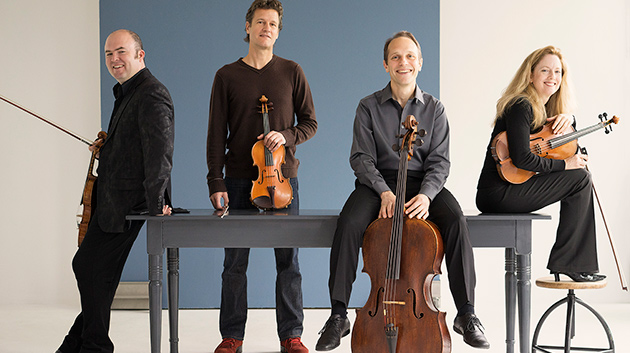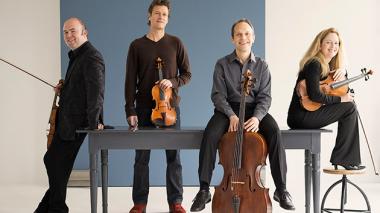
There is a series of Andy Warhol screenprints titled simply Beethoven in which Joseph Karl Stieler’s iconic 1820 portrait of the composer is overlaid with an excerpt from the “Moonlight” Sonata manuscript. In one version of the screenprint Beethoven is blue-faced and blonde. In another, his stern expression has turned an odd shade of green while his wild hair has silvered.
Warhol’s method of repetition and transformation of both Beethoven’s image and music is analogous to the compositional procedures John Adams took in his Second String Quartet, which the St. Lawrence String Quartet premiered at Stanford’s Bing Concert Hall last Sunday.
The work is the third collaboration between Adams and the SLSQ. The group premiered his First Quartet in 2009 and his concerto for string quartet, Absolute Jest, in 2012. The Second Quartet is a kind of sequel to Absolute Jest. Both pieces zoom in on particular passages from Beethoven’s works, which are then varied and obsessively repeated à la Warhol. While Absolute Jest borrows mainly from Beethoven’s late string quartets, the Second Quartet takes its material from the Piano Sonata No. 31, Op. 110.
The jaunty opening theme from the Scherzo of that work serves as the main subject for Adams’ first movement. Adams emphasizes the dancelike character of the theme through slight rhythmic alterations — at one point it even becomes something of a hoedown fiddle tune, calling to mind Adams’ “Mad Cow” movement from Gnarly Buttons. In the second movement, a lyrical passage from the first movement of Op. 110 is presented in a hazy, Debussyan introduction. However, Adams’ signature perpetuum mobile sets in, leading to a frantic sprint of a finale in which the Beethoven theme is pushed to its limits.
The quartet is so saturated with the two Op. 110 excerpts that it becomes more like an arrangement along the lines of Liszt’s operatic paraphrases than an original composition. I would hesitate to call it postmodern; the allusions lack the tongue-in-cheek irony of quotations in the works of John Cage or Louis Andriessen.
In his onstage introduction, Adams professed a kinship with Beethoven, in whose music he senses “deep feeling” and “enormous vitality.” The new quartet demonstrates that much of his musical style is indebted to Beethoven. There are moments in the quartet where you hear Adams’ compositional voice come through, yet these passages morph seamlessly into the familiar Beethoven themes. We're humming those themes, not Adams music, when we leave the auditorium.There are moments where you hear Adams’ compositional voice come through, yet these passages morph seamlessly into the familiar Beethoven themes. We're humming those themes, not Adams music, when we leave the auditorium.
What is more, Adams’ work falls short of his hero’s. The composer joked that the programming of the concert, with his own work sandwiched between Haydn’s Op. 20, No. 5 and Beethoven’s mammoth Op. 131, made him feel like a “chihuahua.”
Yet the German and Austrian shepherds dwarfed Adams in their command of the string quartet genre. Adams, who has been experimenting with more counterpoint in his recent works, lacks the polyphonic clarity of Haydn and Beethoven. The SLSQ brought out the sophistication and complex architecture of Haydn’s fourth-movement fugue and the moments of counterpoint in Beethoven’s quartet. By comparison, Adams’ counterpoint sounded sloppy. Certain passages sounded awkward in the hands of these professional players, and there was more than one unintentional squeak.
This may seem an apples and oranges comparison, but Adams’ Second Quartet begs for it, considering its reliance on Beethoven for both melodic material and form. In fact, Adams’ quartet comes across as an attempt to create his own “late string quartet” in the style of Beethoven.
Yet the SLSQ’s careful reading of the Op. 131 revealed that, though fractured, Beethoven’s piece has a clear emotional trajectory that incorporates both pathos and humor (their exaggerated pizzicati even elicited some laughs from some audience members). While Beethoven carefully lays out his fractured bits in a mosaic, Adams throws his splinters and lets them fall where they land. There isn’t a clear logic moving us from one variation to another, and it’s easy to get lost in the schizophrenia.
In the end, Beethoven was still the hero of the concert. Perhaps this is what Adams wanted — perhaps it is better to hear his work as homage to an unreachable composer. Yet this is not to say that Adams is unworthy of being ranked alongside Beethoven and Haydn. His operatic output alone places him in the pantheon of the Western Classical tradition. It is when Adams utilizes his own compositional voice that he is successful, not when he attempts to create a derivative, Warhol-esque simulacrum.

